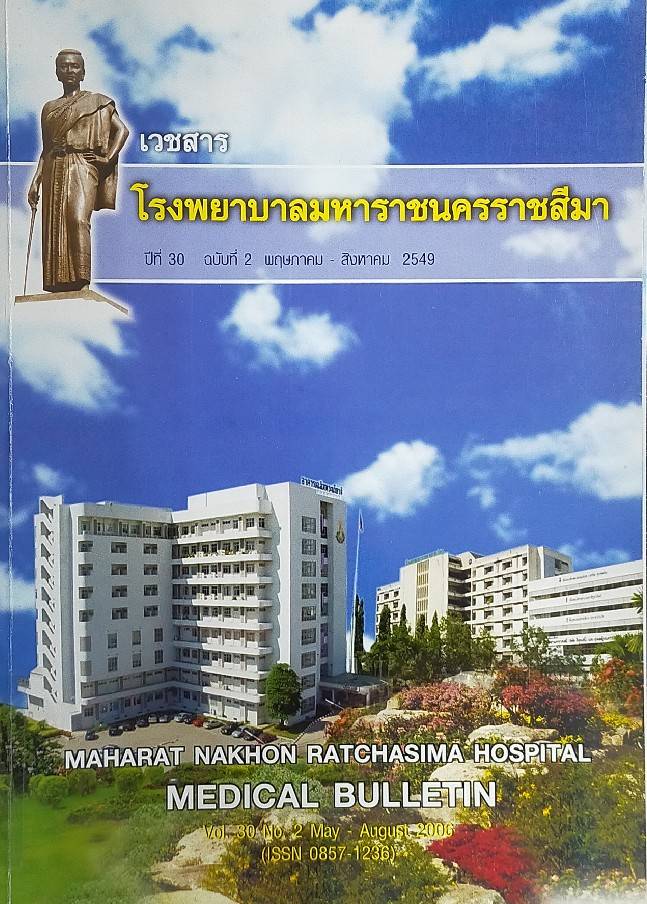การรอดชีพของผู้ป่วยมะเร็งหลังโพรงจมูกในโรงพยาบาลมหาราชนครราชสีมา
Main Article Content
บทคัดย่อ
โรคมะเร็งหลังโพรงจมูกพบบ่อยเป็นอันดับที่ 2 ของโรคมะเร็งศีรษะและคอ การรักษาหลักได้แก่การฉายรังสี หรือการฉายรังสีร่วมกับการให้ยาเคมีบำบัด วัตถุประสงค์: เพื่อศึกษาอัตราการรอดชีพและหาปัจจัยที่มีผลต่ออัตราการรอดชีพของผู้ป่วยมะเร็งหลังโพรงจมูกในโรงพยาบาลมหาราชนครราชสีมา ผู้ป่วยและวิธีการ: ทำการศึกษาย้อนหลังจากเวชระเบียนของผู้ป่วยที่เป็นโรคมะเร็งหลังโพรงจมูกในโรงพยาบาลมหาราชนครราชสีมา ระหว่างปี พ.ศ. 2543-2547 ผลการรักษา: ผู้ป่วย 135 ราย อายุ 16-82 ปี เฉลี่ย 51.4±13.4 ปี อัตราส่วนชายต่อหญิงเท่ากับ 2.5 : 1 เชื้อชาติไทยร้อยละ 99.3 เชื้อชาติจีน ร้อยละ 0.7 ระยะของมะเร็งพบระยะที่ 1, 2, 3 และ 4 เท่ากับ ร้อยละ 3.0, 6.0,10.3 และ 80.7 ตามลำดับ การแพร่กระจายของมะเร็งไปสู่อวัยวะอื่นพบร้อยละ 10.4 อวัยวะที่มีแพร่กระจาย ของมะเร็งบ่อยได้แก่กระดูกและตับ อัตราการรอดชีพ 5 ปี ของผู้ป่วยทั้งหมดร้อยละ 30.7 อัตราการรอดชีพ 5 ปี ของผู้ป่วยที่ที่มาพบแพทย์ในระยะที่ 1, 2, 3 และ4 พบร้อยละ 66.7, 87.5, 78.6 และ 22.7 ตามลำดับ ปัจจัยที่มีผลต่อการรอดชีพของผู้ป่วยอย่างมีนัยสำคัญทางสถิติ (p<0.05) ได้แก่ อายุ ขนาดขอต่อมน้ำเหลือง และการแพร่กระจายของมะเร็งไปสู่อวัยวะอื่น สรุป: ผู้ป่วยที่เป็นโรคมะเร็งหลังโพรงจมูกในโรงพยาบาลมหาราชนครราชสีมา ส่วนใหญ่มาพบแพทย์ในระยะสุดท้าย อัตรารอดชีพ 5 ปี ของผู้ป่วยทั้งหมดเท่ากับร้อยละ 30.7 ปัจจัยที่มีผลต่อการรอดชีพของผู้ป่วยได้แก่ ขนิดของต่อมน้ำเหลืองใหญ่ และการแพร่กระจายของมะเร็งไปสู่อวัยวะอื่น
Article Details

อนุญาตภายใต้เงื่อนไข Creative Commons Attribution-NonCommercial-NoDerivatives 4.0 International License.
เอกสารอ้างอิง
Deerasamee S, Martin N. Sontipong S. Vatanasapt V, Sriplung H. Sriampom S. et al. Cancer in Thailand. Vol II, 1992-1994: IARC Technical Report No.34: Lyon; 1999.p.34-5.
Giri PGS, Sarraf MA. Nasopharyngeal cancer. In:. Ensley JF. Gutkind JS, Jacobs JR, Lippman SM, editors. Head and neck cancer. Emerging perspective Calitornia Academie Press; 2003. p.491-505.
Ho JHC. An epidemiologic and clinical study of nasopha-ryngeal carcinoma. Int J Radiat Oncol Biol Phys 1978; 4: 183-94.
Sivanandan R. Willard EF, Jr. Malignant tumors of the nasopharynx. In: Cummings CW, editor. Otolaryngology Head & Neck Surgery. 4th ed. Pennsynvania Mo Mosby 2005.p.1672-81.
Kabfleisch JD, Prentice RL. The statistical analysis of failure time data. New York: John Wiely & Sons; 1980.
Cox DR, Oakes D. Analysis of survival data. London: Chapman & Hall; 1984.
สถิติสาธารณสุข พ.ศ.2545 (Public Health Statistic 2002). สำนักนโยบายและยุทธศาสตร์ กระทรวงสาธาธารณสุข; 2545. หน้า 114-5.
เฉลิมชัย ชินตระการ, พวงทอง ไกรพิบูลย์, บุญซู กุลประ ดิษฐารมณ์, วิชัย อติชาตการ, ประพจน์ คล่องสู้ศึก, วรชัย รัตนธราธร และคณะ. มะเร็งหลังช่องจมูก ประสบการณ์ การรักษาและติดตามผลระยะเวลา 10 ปี. วารสารหู คอ จมูก และใบหน้า 2536; 1: 1-7.
พินิจ สัญฉนะวณิชย์, สุธี ไกรตระกูล, สมชาติ แสงสะอาด. อนุชา พัวไพโรจน์. มะเร็งหลังโพรงจมูก. วารสารหู คอ จมูก และใบหน้า 2531;; 2: 167-76.
ศเณศร์ แวววิจิตร. Nasopharyngeal carcinoma. วารสารหู คอ จมูก และใบหน้า 2530; 1:35-9.
Cooper JS, Scott C, Marcial V, Griffin T.FazekasJ, Laramore G, et al. The relationship of nasopharyngcal carcinomas and second independent malignancy based on the Radiotherapy Oncology Group experience. Cancer 1991;67:1673-7.
วุฒิพฤกย์ วิสุทธิ์. มะเร็งของโซฟาริงซ์ผลการรักมาด้วยรังสีโคบอลท์. วารสารโรคมะเร็ง 2520;3:59-67.
สุขถมยา จงดี , สุขถมยา วิมล. มะเร็งของเซฟาริงซ์. สารศิริราช2523;32:392-7.
Syed AMN, Puthawala AA, Damore SJ, Chaerlow JM, Austin PA, Sposto R. etal. Brachytherapy for primary and recurrent nasopharyngeal carcinoma: 20 year' experience in Long Beach Memorial. Int J Radiat Oncol Biol Phys 2000; 47: 1311-21.
Tate DJ, Adier JR, Chang SD, Marquez S, Eulau SM, Fee WE, et al. Stereotactic radiosurgical boost following radiotherapy in primary nasopharyngeal carcimoma: Impact on local control. Int I Radiat Oncol Biol Phys19999; 45:915-21.
Lee AWM, Poon YF, Foo W. Retrospective analysis of 5,037 patients with nasopharyngeal carcinoma treated during 1976-1985; Overall survival and patterns of failure. Int J Radiat Oncol Biol Phys 1992; 23: 261-70.
Sanguineti G, Geara FB, Garden AS.Carcinoma ofthe nasopharynx treated by radiotherapy alone: Determinant of local and regional control. Int I Radiat Oncol Biol Phys1997;37:985-96.
Hoppe RT, Goffinet DR, Bagshaw MA.Carcinoma of the masopharynx: Eighteen years' experience with megavoltage radiation therapy. Cancer 1976; 37: 2605-12.
นงพะงา สุวัฒนนันท์. Cancer education in Thailand. วารสารโรคมะเร็ง 2537;20:77-80.
Al-Sarraf M, LeBlanc M, Shanker PG Chemoradiotherapy versus radiotherapy in patients with advanced nasopharyngeal cancer: Phase Ill randomized Intergroup Study 0099. J Clin Oncol 1998; 16: 1310-7.
International Nasopharynx Cancer Study Group: VUMCA I Trial. Prelinary results of a randomized trial comparing ncoadjuvant chemotherapy (cisplatin, epirubicin, bleomycin) plus radiothcrapy vs. radiotherapy alone in stage IV (>N2, MO) undifferentiated nasopharyngcal carcinoma: A positive effect on progression-free survival. Int I Radiat Oncol Biol Phys1996; 35:463-9.
Wang CC. improved local control of nasopharyngeal carcinoma after intracavitary brachytherapy boost. Am J Clin Oncol 1991; 14:5-8
Vikram B, Mishra S. Permanent Iodine-125 (I-125) boost implants after external radiation therapy in nasopharyngeal cancer. Int I Radiat Oncol Biol Phys 1994; 28: 699-701.
Daly JM, Hearne B. Dunaj LePorte B, Vikram b, Strong E, et al. Nutrition rehabilitation in patients with advanced head and neck cancer receiving radiation therapy. Am J Surg 1984; 148: 514-20.


